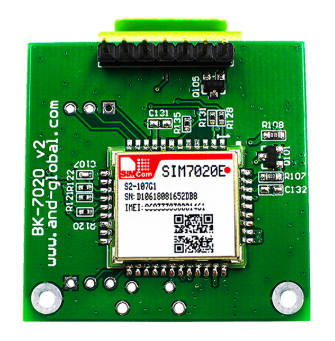Sim7020: Difference between revisions
| Line 75: | Line 75: | ||
=== Receiving data from the device === | === Receiving data from the device === | ||
I'm using the so-called 'custom integration', which is based on a [https://en.wikipedia.org/wiki/Webhook web-hook] | |||
This means that I have configured an URL in the iotcreators dashboard. | |||
When a message from my node comes in, the CDP sends a HTTP POST containing a JSON message to that specific URL and port. | |||
The URL is a server under my control that has an HTTP REST-JSON service running and can process it further. | |||
This is a bit different from how (for example) TheThingsNetwork works: | |||
* TTN publishes incoming data using MQTT | * TTN publishes incoming data using MQTT | ||
* MQTT is a light-weight publish-subscribe framework that decouples producers of data from consumers of data. So for example you can easily have one producer (the node) and several consumers, for example a logger, a data handler, or even a 3rd party that does its own thing with the data. | * MQTT is a light-weight publish-subscribe framework that decouples producers of data from consumers of data. So for example you can easily have one producer (the node) and several consumers, for example a logger, a data handler, or even a 3rd party that does its own thing with the data. | ||
* TTN runs its own MQTT server, so you don't have to. There's no need for setting up your own server, with a public facing ip address, a firewall, security policies, etc. | * TTN runs its own MQTT server, so you don't have to. There's no need for setting up your own server, with a public facing ip address, a firewall, security policies, etc. | ||
* MQTT distinguishes different types of message by different "topics", you can only access topics you are authorised to (your own). So for example, you can easily authorise someone to see device messages, but not allow device registration access. | * MQTT distinguishes different types of message by different "topics", you can only access topics you are authorised to (your own). So for example, you can easily authorise someone to see device messages, but not allow device registration access. | ||
Incoming data received by HTTP POST looks like this: | Incoming data received by HTTP POST looks like this: | ||
| Line 112: | Line 107: | ||
</pre> | </pre> | ||
Data messages always have | Data messages always have one report, with resourcepath set to "uplinkMsg/0/data". | ||
=== Support in my LoraLuftdatenForwarder === | === Support in my LoraLuftdatenForwarder === | ||
Revision as of 08:05, 3 April 2021
| Project Sim7020 | |
|---|---|

| |
| SIM7020 NB-IOT modem | |
| Status | In progress |
| Contact | bertrik |
| Last Update | 2021-04-03 |
What
This page is about the SIM7020 NB-IOT module.
I want to experiment with this kind of network connectivity for either a bat activity monitor or air quality monitoring (particulate matter). The t-mobile portal at http://portal.iot.t-mobile.nl is dead. Use the iotcreators portal.
Status:
- I can send data from the SIM7020 to the network
- I can receive the data from the network in my own application, using the webhook
Next steps:
- find an Arduino library for this
- what things need to be configured? put these in EEPROM?
- think about encoding data
- start sending data!
Hardware
I wired it up like this:
| SIM7020 | USB serial | Remark |
|---|---|---|
| G | nc | looped to SIM7020-K |
| R | TXD | |
| T | RXD | |
| K | nc | looped to SIM7020-G |
| V | 3V3 | |
| G | GND | |
| S | DTR |
Software
Network setup
See:
- https://docs.iotcreators.com/docs/general-settings for general network settings
- https://docs.iotcreators.com/docs/_-2-attach-to-nb-iot-network for specific AT-commands
Things that need to be configured for the network and the backend:
- network: band (8), operator (20416), APN (cdp.iot.t-mobile.nl)
- backend: UDP server ip (172.27.131.100) and port (15683)
Receiving data from the device
I'm using the so-called 'custom integration', which is based on a web-hook This means that I have configured an URL in the iotcreators dashboard.
When a message from my node comes in, the CDP sends a HTTP POST containing a JSON message to that specific URL and port. The URL is a server under my control that has an HTTP REST-JSON service running and can process it further.
This is a bit different from how (for example) TheThingsNetwork works:
- TTN publishes incoming data using MQTT
- MQTT is a light-weight publish-subscribe framework that decouples producers of data from consumers of data. So for example you can easily have one producer (the node) and several consumers, for example a logger, a data handler, or even a 3rd party that does its own thing with the data.
- TTN runs its own MQTT server, so you don't have to. There's no need for setting up your own server, with a public facing ip address, a firewall, security policies, etc.
- MQTT distinguishes different types of message by different "topics", you can only access topics you are authorised to (your own). So for example, you can easily authorise someone to see device messages, but not allow device registration access.
Incoming data received by HTTP POST looks like this:
{
"reports": [
{
"serialNumber": "IMEI:868333030676163",
"timestamp": 1615660679246,
"subscriptionId": "06f872fc-02b3-4b20-8394-3f19a7006ca9",
"resourcePath": "uplinkMsg/0/data",
"value": "01a3021c"
}
],
"registrations": [],
"deregistrations": [],
"updates": [],
"expirations": [],
"responses": []
}
Data messages always have one report, with resourcepath set to "uplinkMsg/0/data".
Support in my LoraLuftdatenForwarder
I've added preliminary support for this, see: https://github.com/bertrik/LoraLuftdatenForwarder/tree/nbiot/LoraLuftdatenForwarder/src/main/java/nl/bertriksikken/nbiot
References
I followed roughly this guide:
- Ordered a SIM7020 and a starter kit, see https://www.hackster.io/voske65/arduino-nb-iot-with-sim7020-and-t-mobile-027f8f
- Regional settings for the network: https://docs.iotcreators.com/docs/general-settings
- t-mobile IOT configuration page: https://portal.iotcreators.com/ ?